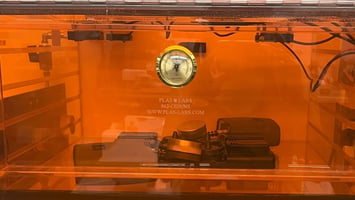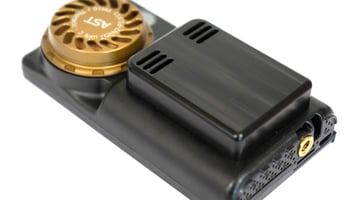Timestamps in UPAS log files In log files written by Ultrasonic Personal Air Samplers (UPAS),...
Where’s the Noise? Where's the Pulsation? A quick explainer on UPAS technology.
 We’re a team of mostly scientists and engineers and that means we’re going to come up with nerdy sometimes-too-literal naming conventions. Where does the UPAS acronym come from? UPAS stands for Ultrasonic Personal Aerosol Sampler or, as we’re seeing more and more folks expand beyond aerosols, UPAS can also stand for Ultrasonic Personal Air Sampler. So why that name? In this post, let's focus on the ultrasonic part. Ultrasonic can mean a few things. In our case, our products and patents involve the use of ultrasonic pumps to move air. An ultrasonic pump is a special kind of pump that relies on flexible piezoelectric discs driven at high frequency (about 25,000 cycles per second). Something sonic is usually referring to sound, latin sonus for sound, or something done by sound.
We’re a team of mostly scientists and engineers and that means we’re going to come up with nerdy sometimes-too-literal naming conventions. Where does the UPAS acronym come from? UPAS stands for Ultrasonic Personal Aerosol Sampler or, as we’re seeing more and more folks expand beyond aerosols, UPAS can also stand for Ultrasonic Personal Air Sampler. So why that name? In this post, let's focus on the ultrasonic part. Ultrasonic can mean a few things. In our case, our products and patents involve the use of ultrasonic pumps to move air. An ultrasonic pump is a special kind of pump that relies on flexible piezoelectric discs driven at high frequency (about 25,000 cycles per second). Something sonic is usually referring to sound, latin sonus for sound, or something done by sound.
Sound waves carry energy and we humans have sound sensors attached to our heads (ears). Our ears can only pick up some of the possible frequencies of sound. If the frequency is too low (sub-sonic) or too high (ultra-sonic) our ears won’t pick it up.
So ultrasonic technologies are effectively silent not because they aren’t transmitting energy using sound waves. It’s just that we can’t pick up the sounds being produced with our ears.
Shall we get nerdier? Yes, let’s.
UPAS products use ultrasonic pumps and they have this neat trick baked in that we don’t hear them because they are working at frequencies (or pitch) above what we can hear. Why bother? It turns out one of the most frequent objections to wearing sampling pumps is the noise and vibration (often called pulsation) of the pumps. This neat little ultrasonic pumping trick creates two key benefits: virtually no noise during operation and no detectable pulsation. People wearing our pumps can’t tell they're on. Folks often need to put the exhaust right up to their ear to hear the soft sound of white noise of exiting the pumps.
Can we visualize this a little bit more? You betcha! Let’s use some low-cost sensors and an oscilloscope from our lab to make some of these invisible things visible.
First up is the classic electret microphone. You can buy these fun little items for a couple bucks off your favorite electronics hobby site. Provide some low voltage power and send the output signal into our oscilloscope to visualize the sounds it picks up.
Check out this video of moving a classic diaphragm pump closer and closer to the microphone. You’ll see the amplitude of the sound being detected creep up and up until it’s off the scale.

Now check out the next video showing the same activity using our UPAS v2.1 PLUS instrument. We get closer and closer but can’t seem to get our baseline to budge. That’s because these pumps are so much quieter across the whole sound spectrum our microphone doesn’t ‘hear it.’

 Pretty fun! But what about pulsation? Pulsation is not the same as sound. If you’ve ever picked up an aeration pump for an aquarium you know that cyclical vibration in your hands. That pulsation is pretty much inherent to the classical diaphragm pump design. Diaphragm pumps are moving at a slow frequency which is easy for us humans to hear and feel. We feel the wiggling diaphragm pumps when we wear the old technology. We can visualize pulsation using an accelerometer (also called an inertial measurement unit). These little devices are everywhere in modern electronics. Ever wonder why your phone knows to rotate the image on your screen when you rotate from portrait to landscape? It has an accelerometer measuring the pull of gravity! So an accelerometer measures things like gravity but more generally acceleration. A pulsation is little more than a rocking motion accelerating you back and forth, back and forth. So let’s use an accelerometer to visualize the difference between the old technology and UPAS technology.
Pretty fun! But what about pulsation? Pulsation is not the same as sound. If you’ve ever picked up an aeration pump for an aquarium you know that cyclical vibration in your hands. That pulsation is pretty much inherent to the classical diaphragm pump design. Diaphragm pumps are moving at a slow frequency which is easy for us humans to hear and feel. We feel the wiggling diaphragm pumps when we wear the old technology. We can visualize pulsation using an accelerometer (also called an inertial measurement unit). These little devices are everywhere in modern electronics. Ever wonder why your phone knows to rotate the image on your screen when you rotate from portrait to landscape? It has an accelerometer measuring the pull of gravity! So an accelerometer measures things like gravity but more generally acceleration. A pulsation is little more than a rocking motion accelerating you back and forth, back and forth. So let’s use an accelerometer to visualize the difference between the old technology and UPAS technology.
First up the diaphragm tech. If we lay the corner of the pump on top of the accelerometer and watch what happens we see a periodic pattern. The pulsation of the diaphragm pump shows up as that wave pattern on the oscilloscope.

Now let’s look at the UPAS v2.1 PLUS.

Well, we can’t really see much, can we? That’s because the UPAS does not pulsate (or at least not enough to detect with this quick test).
One of our favorite moments is seeing the look on someone’s face as they experience UPAS technology for the first time. “It’s so quiet.” “I can’t even tell it’s on.”
We’ve gone through some of the core explanations of how the UPAS accomplishes some of its key benefits.
Have any feedback for us? Please leave a comment below. Want to try one out for yourself? Fill out this form and we’ll get back to you about a free trial. Need something else? Shoot us an email.




